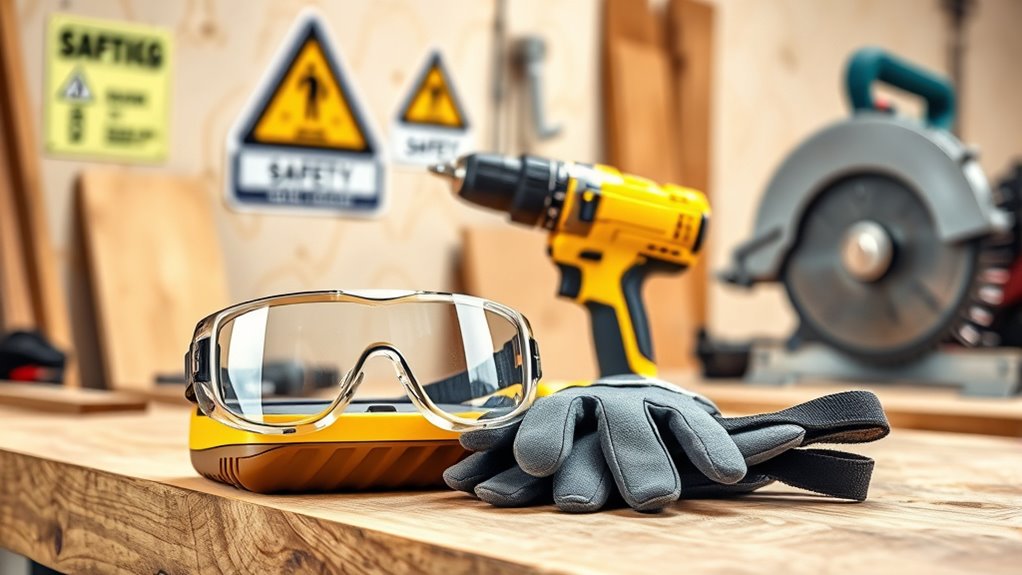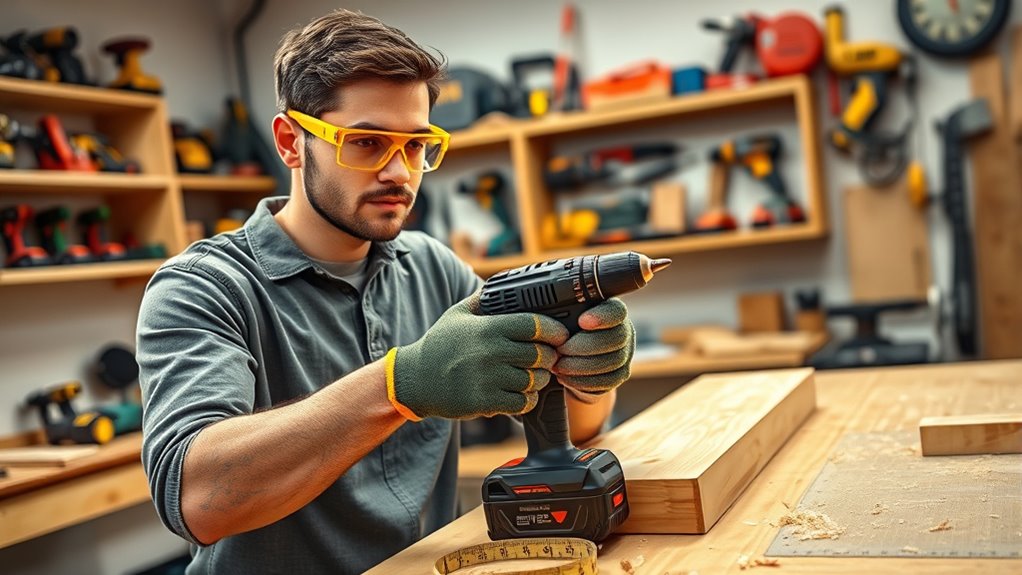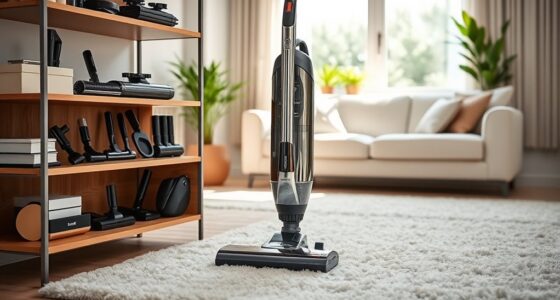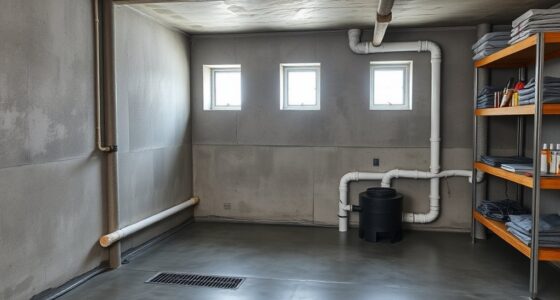To stay safe with power tools, always get proper training and make certain your tools are in good condition. Wear protective gear like safety glasses, gloves, and ear protection to guard against common injuries. Keep cords away from heat and sharp edges, and secure your workpieces to prevent slips. Maintain a tidy workspace and follow manufacturer instructions carefully. If you stick to these basics, you’ll greatly reduce your risk of accidents and injuries—continue to explore more safety tips to stay even safer.
Key Takeaways
- Always wear appropriate personal protective equipment like safety glasses and gloves when operating power tools.
- Ensure tools are in good condition, properly maintained, and inspected for damage before use.
- Secure workpieces with clamps or vices to prevent slips and ensure stability during cutting or drilling.
- Keep cords and hoses away from heat, sharp edges, and moving parts to avoid damage and accidents.
- Receive proper training and follow manufacturer instructions to operate tools safely and prevent injuries.

Are you aware of how common power tool injuries are and the serious risks they pose? Every year, over 960,000 injuries occur due to power tools, with many resulting in electric shocks, eye injuries, puncture wounds, crushing injuries, or even amputations. These numbers highlight the importance of understanding safety measures before operating any power tool. Some tools, like chain saws, table saws, and circular saws, are particularly hazardous because of their high injury rates. As a beginner, it’s essential to recognize these risks and take steps to minimize them. Proper training and experience are crucial; never attempt to operate a power tool without understanding its proper use. You should also keep your tools in good condition, as poorly maintained equipment increases the chances of accidents. Regularly inspecting your tools for damage, worn parts, or loose components helps prevent malfunctions that could lead to injuries.
Safety begins with awareness. Always keep cords and hoses away from heat, oil, or sharp edges to avoid damage. When you’re not using the tool, unplug it immediately to prevent accidental starts. Securing your workpieces with clamps or vices ensures stability, reducing the risk of slips or kickbacks. Wearing the right personal protective equipment is vital—gloves, safety glasses, and hearing protection shield you from common hazards. Good footing and maintaining balance while operating power tools help you stay in control. Remember, many injuries happen because of improper handling, accidental starts, or entanglements with loose clothing. Being mindful of these hazards can considerably reduce your risk.
Hand injuries are among the most common, accounting for about 30% of construction-related injuries. Saws and drills frequently cause these injuries, especially when safety protocols aren’t followed. Electric shocks can cause serious health issues like burns or heart fibrillation, so always ensure your tools are properly grounded and in good working order. Puncture wounds and crushing injuries happen when tools are mishandled or used improperly, emphasizing the need for proper technique. In severe cases, incorrect use of saws or grinders can lead to amputations, which are devastating and preventable with proper precautions. Recognizing the importance of proper maintenance can significantly reduce the risk of such accidents and extend the lifespan of your tools.
Older workers, particularly those between 51 and 70 years old, tend to experience higher injury rates, partly due to decreased physical agility. Regardless of your age, thorough training and adherence to safety protocols are essential. For specific tools like chain saws, maintain a proper grip and stance; for table saws, secure your workpiece to prevent kickback; and for circular saws, handle blades carefully to avoid exposure. Drills should be used with correct bit selection and a secure grip, while nail guns require cautious handling to prevent accidental firing.
Preventing accidents requires regular maintenance, proper training, and organized workspaces. Follow OSHA guidelines and safety standards to stay compliant. Conduct routine safety inspections and report incidents to improve safety protocols. Keeping your workspace clean and organized helps avoid tripping hazards and unnecessary mishaps. Remember, safety isn’t just about protecting yourself; it’s about creating a safe environment for everyone involved. By understanding these risks and implementing safety measures, you’re taking essential steps to operate power tools confidently and responsibly.
Frequently Asked Questions
How Do I Choose the Right Power Tool for My Project?
When choosing the right power tool for your project, start by evaluating your specific needs. Determine the scope, materials, and complexity of your work. Consider whether a corded or cordless option suits your mobility and duration needs. Think about essential features like adjustable speeds, safety features, and ease of use. Budget wisely, prioritizing quality for frequently used tools, and plan for future upgrades to match your growing skills and project demands.
What Should I Do if a Power Tool Malfunctions?
Imagine your power tool suddenly sputters—what’s your move? First, stop using it immediately and unplug it. Don’t try to fix it yourself; instead, notify your supervisor or a qualified technician. Remove the defective tool from service, label it accordingly, and wait for proper repair or replacement. Always follow safety procedures, and never ignore signs of malfunction—they’re warning flags you can’t afford to overlook.
Are There Specific Safety Gear Requirements for Different Tools?
You need to wear the right safety gear for each tool to stay protected. For example, always wear ANSI Z87.1 safety glasses or goggles when using cutting or grinding tools to shield your eyes from debris. Use face shields for larger particles, ear protection for noisy tools, and respirators or masks when dust or fumes are present. Gloves and protective clothing are also essential to prevent cuts, abrasions, and injuries, depending on the tool.
How Often Should I Inspect My Power Tools for Safety?
You should inspect your power tools regularly to guarantee safety. Perform quick checks before each use to verify safety devices, cords, and switches are working properly. Conduct weekly inspections of critical components like safety guards and electrical cords. For more thorough checks, do monthly or quarterly inspections, especially following the manufacturer’s recommendations. Keep detailed logs of inspections to track issues, maintain safety standards, and comply with regulations.
Can I Use Power Tools if I Am Inexperienced?
You might wonder if you can use power tools as an inexperienced user. While it’s possible, it’s risky without proper training and knowledge. Always seek instruction or supervision before starting, and start with simpler tools. Follow safety guidelines, wear protective gear, and make certain your tools are in good condition. Taking these steps minimizes injury risks and builds your confidence to handle more complex equipment safely.
Conclusion
By following these safety tips, you protect yourself from injuries, prevent accidents, and guarantee your projects succeed. Always wear protective gear, stay alert, and use tools properly. Keep your workspace organized, inspect tools regularly, and never rush through a task. Prioritize safety over speed, caution over convenience, and awareness over assumption. Remember, your safety is your responsibility, your best tool, and your greatest priority—because a cautious approach leads to confident craftsmanship and safe, successful results.










